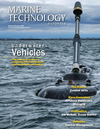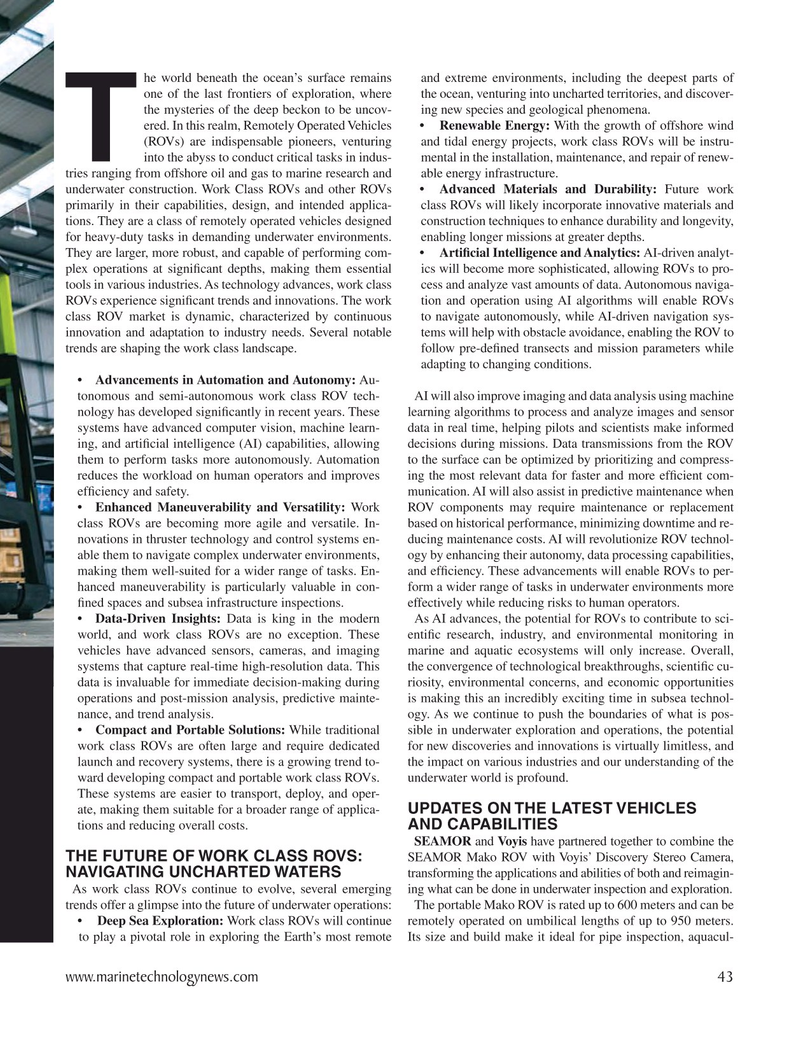
Page 43: of Marine Technology Magazine (January 2024)
Read this page in Pdf, Flash or Html5 edition of January 2024 Marine Technology Magazine
he world beneath the ocean’s surface remains and extreme environments, including the deepest parts of one of the last frontiers of exploration, where the ocean, venturing into uncharted territories, and discover- the mysteries of the deep beckon to be uncov- ing new species and geological phenomena.
ered. In this realm, Remotely Operated Vehicles • Renewable Energy: With the growth of offshore wind (ROVs) are indispensable pioneers, venturing and tidal energy projects, work class ROVs will be instru-
T into the abyss to conduct critical tasks in indus- mental in the installation, maintenance, and repair of renew- tries ranging from offshore oil and gas to marine research and able energy infrastructure.
underwater construction. Work Class ROVs and other ROVs • Advanced Materials and Durability: Future work primarily in their capabilities, design, and intended applica- class ROVs will likely incorporate innovative materials and tions. They are a class of remotely operated vehicles designed construction techniques to enhance durability and longevity, for heavy-duty tasks in demanding underwater environments. enabling longer missions at greater depths.
They are larger, more robust, and capable of performing com- • Arti? cial Intelligence and Analytics: AI-driven analyt- plex operations at signi? cant depths, making them essential ics will become more sophisticated, allowing ROVs to pro- tools in various industries. As technology advances, work class cess and analyze vast amounts of data. Autonomous naviga-
ROVs experience signi? cant trends and innovations. The work tion and operation using AI algorithms will enable ROVs class ROV market is dynamic, characterized by continuous to navigate autonomously, while AI-driven navigation sys- innovation and adaptation to industry needs. Several notable tems will help with obstacle avoidance, enabling the ROV to trends are shaping the work class landscape. follow pre-de? ned transects and mission parameters while adapting to changing conditions.
• Advancements in Automation and Autonomy: Au- tonomous and semi-autonomous work class ROV tech- AI will also improve imaging and data analysis using machine nology has developed signi? cantly in recent years. These learning algorithms to process and analyze images and sensor systems have advanced computer vision, machine learn- data in real time, helping pilots and scientists make informed ing, and arti? cial intelligence (AI) capabilities, allowing decisions during missions. Data transmissions from the ROV them to perform tasks more autonomously. Automation to the surface can be optimized by prioritizing and compress- reduces the workload on human operators and improves ing the most relevant data for faster and more ef? cient com- ef? ciency and safety. munication. AI will also assist in predictive maintenance when • Enhanced Maneuverability and Versatility: Work ROV components may require maintenance or replacement class ROVs are becoming more agile and versatile. In- based on historical performance, minimizing downtime and re- novations in thruster technology and control systems en- ducing maintenance costs. AI will revolutionize ROV technol- able them to navigate complex underwater environments, ogy by enhancing their autonomy, data processing capabilities, making them well-suited for a wider range of tasks. En- and ef? ciency. These advancements will enable ROVs to per- hanced maneuverability is particularly valuable in con- form a wider range of tasks in underwater environments more ? ned spaces and subsea infrastructure inspections. effectively while reducing risks to human operators.
• Data-Driven Insights: Data is king in the modern As AI advances, the potential for ROVs to contribute to sci- world, and work class ROVs are no exception. These enti? c research, industry, and environmental monitoring in vehicles have advanced sensors, cameras, and imaging marine and aquatic ecosystems will only increase. Overall, systems that capture real-time high-resolution data. This the convergence of technological breakthroughs, scienti? c cu- data is invaluable for immediate decision-making during riosity, environmental concerns, and economic opportunities operations and post-mission analysis, predictive mainte- is making this an incredibly exciting time in subsea technol- nance, and trend analysis. ogy. As we continue to push the boundaries of what is pos- • Compact and Portable Solutions: While traditional sible in underwater exploration and operations, the potential work class ROVs are often large and require dedicated for new discoveries and innovations is virtually limitless, and launch and recovery systems, there is a growing trend to- the impact on various industries and our understanding of the ward developing compact and portable work class ROVs. underwater world is profound.
These systems are easier to transport, deploy, and oper- ate, making them suitable for a broader range of applica-
UPDATES ON THE LATEST VEHICLES tions and reducing overall costs.
AND CAPABILITIES
SEAMOR and Voyis have partnered together to combine the
THE FUTURE OF WORK CLASS ROVS: SEAMOR Mako ROV with Voyis’ Discovery Stereo Camera,
NAVIGATING UNCHARTED WATERS transforming the applications and abilities of both and reimagin-
As work class ROVs continue to evolve, several emerging ing what can be done in underwater inspection and exploration.
trends offer a glimpse into the future of underwater operations: The portable Mako ROV is rated up to 600 meters and can be • Deep Sea Exploration: Work class ROVs will continue remotely operated on umbilical lengths of up to 950 meters. to play a pivotal role in exploring the Earth’s most remote Its size and build make it ideal for pipe inspection, aquacul- www.marinetechnologynews.com 43
MTR #1 (34-49).indd 43 1/30/2024 6:16:47 PM

 42
42

 44
44
